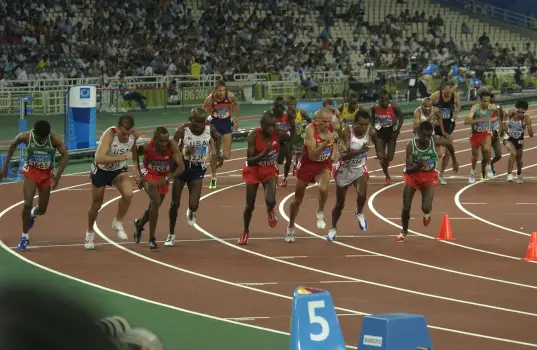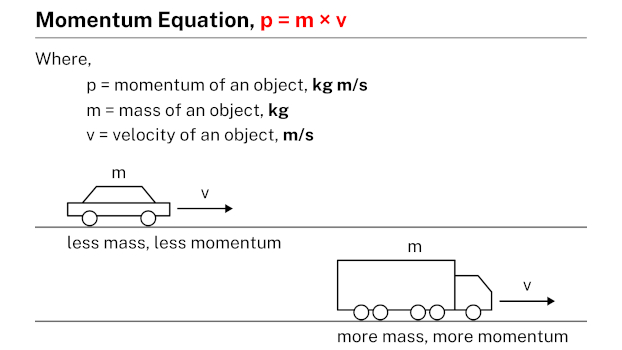Momentum quantifies the motion of an object. It is determined by multiplying the object’s mass by its velocity. In simpler terms, momentum represents the amount of motion an object possesses. When an object is in motion, it has momentum. The greater the mass and velocity of the object, the greater its momentum. Momentum plays a crucial role in understanding the interactions and behavior of objects during collisions or when acted upon by external forces. It is a conserved quantity, meaning that the total momentum of a system remains constant unless external forces are applied.
Examples
Large truck

A large truck running on the highway possesses a significant amount of momentum due to its substantial mass. Momentum is the product of an object’s mass and its velocity. In the case of the truck, its large mass contributes to its high momentum. As a result, when the truck needs to come to a stop, it requires a longer distance to do so compared to a smaller vehicle with less momentum. The truck’s high momentum makes it harder to stop quickly and requires a greater braking force and a longer braking distance. Due to its large momentum, the truck takes a longer time to stop completely, even after the driver applies the brakes.
Athlete

When an athlete is running in a race with a certain velocity, they possess momentum. Momentum is a property of an object in motion and is determined by its mass and velocity. In the case of the athlete, their momentum is a result of both their body mass and the speed at which they are running. The greater the mass and velocity of the athlete, the higher their momentum.
Football

When a football is struck on the head, it possesses a significant amount of momentum, resulting in a sensation of pain. The momentum of a football arises from its combined mass and velocity. As the football moves, it possesses both these attributes, which contribute to its momentum. The magnitude of the football’s momentum increases as its velocity increases. Consequently, when the football impacts the head, the transfer of momentum leads to the experience of pain.
Tennis

When a tennis ball collides with a racket at a high velocity, its momentum is influenced by its mass. Since a tennis ball has a relatively small mass, it possesses a smaller momentum compared to objects with greater mass. As a result, even if a player strikes the tennis ball with less force, it can still travel a considerable distance due to its lower momentum. The combination of the ball’s high velocity and smaller mass allows it to cover a greater distance upon impact with the racket.
Car

When a car is in motion, it possesses momentum, which is determined by its mass and velocity. The momentum of a car is a measure of how difficult it is to stop or change its motion. A car with a larger mass will have a greater momentum compared to a car with a smaller mass, given the same velocity. Similarly, a car traveling at a higher velocity will have a greater momentum compared to a car moving at a lower velocity, given the same mass.
Bike

When a bike is in motion on a hill, it possesses momentum, which is influenced by its mass and velocity. Due to its smaller mass compared to a car, the bike has a lower momentum. This characteristic makes it advantageous for riding on hilly terrains as it can decelerate and come to a stop more quickly than a four-wheeler. The combination of a smaller mass and the bike’s ability to reduce momentum efficiently allows for better control and faster stopping when navigating hills.
Punch

A karate champion’s punch possesses significant momentum, which allows it to exert a powerful force on its target. The high velocity generated by the swift movement of the champion’s arm, combined with the forceful impact delivered, results in a substantial amount of momentum. This momentum is transferred to the target, enabling the punch to break a brick or potentially cause injury to an opponent’s face. The greater the momentum behind the punch, the greater its potential impact and destructive force.
Running

When an individual is running on the ground, they possess momentum that makes it challenging to stop suddenly. Momentum is the product of an object’s mass and velocity. As the individual’s velocity increases during their run, their momentum also increases. This means that the faster they run, the greater their momentum becomes, and the more difficult it is for them to come to a halt. The relationship between velocity and momentum is directly proportional, emphasizing the difficulty in stopping quickly when running at higher speeds.
Airplane

When an airplane makes a landing on the runway, it possesses significant momentum due to its large mass and high velocity. Momentum is the product of an object’s mass and velocity, and in the case of an airplane, both factors contribute to its substantial momentum. As a result, it becomes challenging for an airplane to stop immediately after landing, much like cars and bikes. The high momentum of the airplane requires a considerable braking force and a longer distance to come to a complete stop. The pilot must carefully manage the deceleration process to safely bring the airplane to a halt on the runway.
Equation

The momentum equation states that momentum (p) is calculated as the product of an object’s mass (m) and its velocity (v). Mathematically, the equation of momentum is expressed as p = m × v. This equation allows for the determination of the momentum of an object based on its mass and velocity.
Practice problems
Problem #1
Calculate the momentum of a 2 kg ball rolling towards the east with a velocity of 3 m/s.
Solution
Given data:
- Momentum of a ball, p = ?
- Mass of a ball, m = 5 kg
- Velocity of a ball, v = 3 m/s
Applying the formula:
- p = m × v
- p = 5 × 3
- p = 15 kg m/s
Therefore, the momentum of a ball is 15 kg m/s towards the east.
Problem #2
A car with a mass of 800 kg is moving towards the north with a velocity of 10 m/s. What is the momentum of the car?
Solution
Given data:
- Mass of a car, m = 800 kg
- Velocity of a car, v = 10 m/s
- Momentum of a car, p = ?
Applying the formula:
- p = m × v
- p = 800 × 10
- p = 8000 kg m/s
Therefore, the momentum of a car is 8000 kg m/s towards the north.
Problem #3
What is the momentum of a 3000 kg truck traveling on the highway towards the west with a velocity of 8 m/s?
Solution
Given data:
- Momentum of a truck, p = ?
- Mass of a truck, m = 3000 kg
- Velocity of a truck, v = 8 m/s
Applying the formula:
- p = m × v
- p = 3000 × 8
- p = 24000 kg m/s
Therefore, the momentum of a truck is 24000 kg m/s towards the west.
Problem #4
If a bicycle with a mass of 5 kg is moving at a velocity of 15 m/s towards the south, what is the momentum of the bicycle?
Solution
Given data:
- Mass of a bicycle, m = 5 kg
- Velocity of a bicycle, v = 15 m/s
- Momentum of a bicycle, p = ?
Applying the formula:
- p = m × v
- p = 5 × 15
- p = 75 kg m/s
Therefore, the momentum of a bicycle is 75 kg m/s towards the south.
More topics
- Drag (physics)
- Gravity
- Inertia
- Acceleration
- Momentum
- Mass
- Velocity
- Friction
External links
- Momentum: Explanation, Review, and Examples – Albert
- Momentum Examples – SoftSchools.com
- Momentum – The Physics Classroom
- Momentum – Maths Is Fun
- Momentum – Picture Physics
- Momentum | Definition, Equation, Units & Examples – Study.com
- Momentum | Definition, Examples, & Facts – Britannica
- Momentum Definition & Meaning – Merriam-Webster
- Examples of ‘momentum’ in a sentence – Collins Dictionary
- Examples of “Momentum” in a Sentence – YourDictionary
- Momentum – Physics Tutorials
- Momentum – Wikipedia
- Momentum (Physics): Definition, Equation, Units (w/ Diagrams & Examples) – Sciencing
- MOMENTUM – Cambridge Dictionary
- What is momentum? What are some examples? – Quora
- Momentum Equation| Definition and Examples – What’s Insight
Deep
Learnool.com was founded by Deep Rana, who is a mechanical engineer by profession and a blogger by passion. He has a good conceptual knowledge on different educational topics and he provides the same on this website. He loves to learn something new everyday and believes that the best utilization of free time is developing a new skill.
